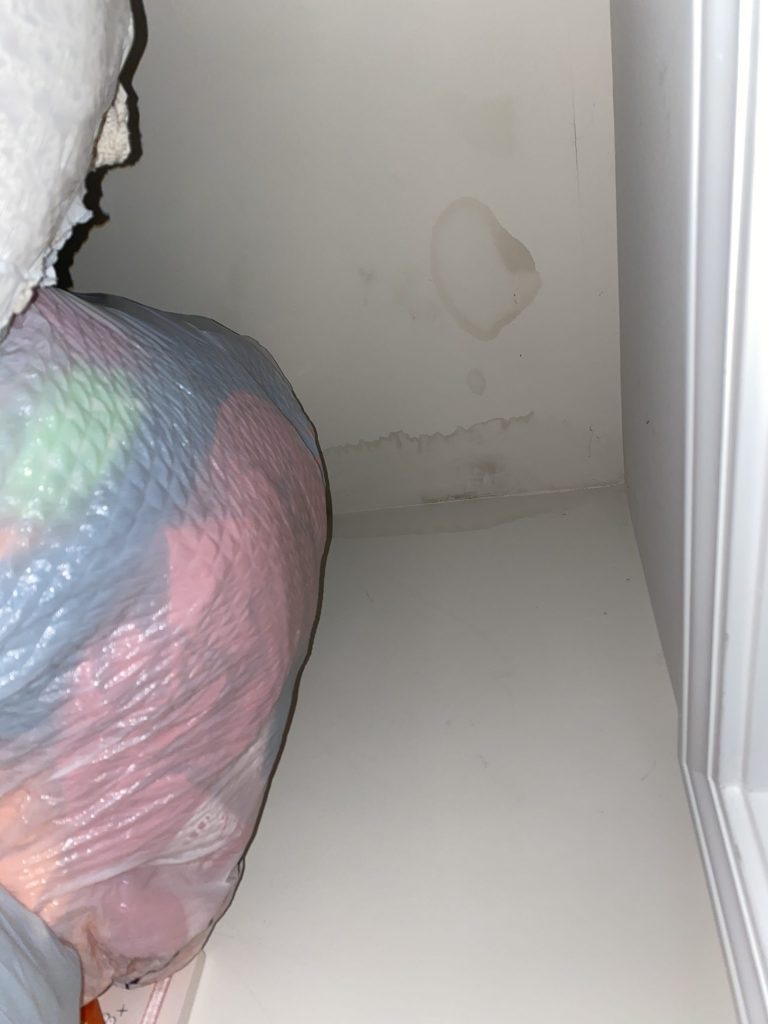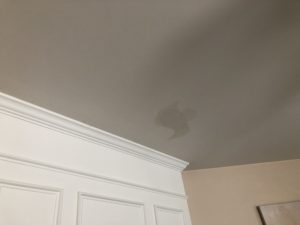Roof leaks can cause significant problems for residential homeowners and commercial property owners. Water damage isn’t exclusive to the roofing area, the presence of roof leaks can cause substantial damage to the interior of your home, and the effects can spread down multiple levels of a building. The hardest part of repairing a roof leak is finding the source of the leak in the first place – especially if you have a steeply pitched roof. Since the leak source doesn’t always match where you’re seeing the leak inside the home, and there may be multiple causes, this step is uniquely challenging. This step is where many homeowners throw up their hands in frustration and start looking for quick, cheap roof leak repairs that do not turn out to be a long-term solution.
Part of our mission here at Signature Exteriors is to provide high-quality roofing services to the Charlotte, NC area – even if you choose another roofing contractor to perform your roof leak repairs. Our goal is only to provide you with proper roofing knowledge so that, however you decide to repair your roof leak, you can make that decision with confidence. The experts here at Signature Exteriors have put together a guide to help you determine the cause of your roof leak, locate the source of your roof leak, and how to fix the leak in your roof.
Causes of Roof Leaks
We mentioned earlier that several factors could cause roof leaks. There are common causes of roof leaks, such as old, damaged shingles, but the reason can be as intricate as poor flashing installation or even clogged gutters or a cracked vent pipe. As you start to determine the cause of your roof leak, we recommend starting here.
Roof Age – Cracked, Missing, or Rotting Shingles
Roofing materials deteriorate with age. Shingles that have lived through years of storms and changes in seasons tend to become worn and brittle – leading to cracks that allow water through. Have you thought about hiring a residential roof contractor to perform roof maintenance? This kind of repair can mean resealing roof vents, addressing minor nail pops, or replacing a few shingles. Suppose you don’t want to hire a roofing contractor. In that case, you can purchase roofing materials, like this product typically available at Lowe’s or Home Depot, and perform these minor roof repairs yourself.
Roof Vents/Boots – Sealant and Age
Roof vents are the weakest part of a roofing system since they’re a penetration. This roofing term describes any component that penetrates a roof deck which increases the risk of a leak originating at that location. The boots around roof vents are often made with plastic and are prone to drying and cracking with age. Roof leaks originating from these vents often leave water stains, dark spots, and wet areas on the underside of your decking – you’ll likely be able to see this in your attic space.
Clogged Gutters
The purpose of gutters is to direct water away from your home. When your gutter system becomes clogged, the water can back up underneath your shingles or run down your siding. Leaks caused by clogged gutters are often identified due to peeling paint or streaks down a vertical wall.
There are so many factors that can cause a roof leak. We’ve outlined a few more in a different article – 5 Common Causes of Roof Leaks – if you’d like to learn more.
Locating The Leak Source
Identifying the leak source is the most critical step in repairing a roof leak, but it’s not an exact science. Roofing contractors have years of experience in finding roof leaks, so we recommend you reach out to a local roofer if you’re having trouble identifying the source of your roof leak.
#1: Locate the leak on the inside of the home. Confirm the water on the house’s interior is the result of a roof leak and is not due to another component such as plumbing or the HVAC system.
#2: Once you confirm the leak source is likely roof related, measure the location of the leak from two fixed points such as perpendicular exterior walls, a fireplace chimney, or other components that extend through the finished ceiling to the attic space or roof surface.
#3: Go into your attic and locate the source of the leak on the underside of the roof deck using the measurements taken from your home living space. Review the leak area from the attic to determine which roof components appear to be leaking. Be mindful that water does run with gravity and along rafters, so expand your view and make sure you identify where the water seems to be coming from, not just where it’s ending up.
#4: Measure the location of the roof leak source from inside the attic space using two fixed points such as vent pipes or chimneys.
#5: Go onto your roof, most importantly make sure to take appropriate safety precautions, and inspect the roof surface based on the measurements taken from the attic. Adjust your measurements depending on the overhang of your roof – but this should provide you with the relevant exterior surface area to inspect.
#6: Determine the approximate location where water is penetrating the roof to get into your attic space. Begin to work outwards from where you believe the roof leak started and check for cracked shingles, nail pops, roof penetrations that may need a sealant or new boots, and missing shingles.
Pro Note: Your roofing material can play a role in how difficult it is to find a roof leak. Metal roofing, for example, is sometimes difficult to pinpoint a roof leak source since the water does not stick or absorb at all into the surface. If you have a roof leak on your metal roof, it may be wise to schedule a free inspection with a roofing company near you.
How To Fix a Roof Leak
Before we start, we highly recommend you take advantage of free roof inspections or cost-effective roof maintenance packages through a local reputable roofing contractor to help you repair your roof leaks. Performing DIY roof leak repairs can be a great option but does come with the risk of wasting time, material, and money if you haven’t identified all of the contributing factors of your roof leak. However, we understand entirely professional repairs aren’t everyone’s first choice, so we’ve put together tips for fixing your roof leaks below.
#1: Straighten and re-attach curled shingles
Over time, asphalt shingles can start to curl at their corners, and these curls can trap water and cause cracks in the shingle. Carefully smooth out any curled shingles and use a caulking gun to place a dab of roof sealant under the raised corners. Press the shingle down. You can also use a trowel at this stage to cover the shingle edges with roofing cement.
#2: Fix cracked shingles with roof sealant
There’s no need to replace an entire shingle if it has a clean tear. Instead, apply a thick bead of roof sealant under the crack with a caulking gun. Press the shingle down, then apply another bead of sealant over the crack. Use a putty knife to spread the top bead over both cracked edges.
#3: Replace broken or missing shingles
If all or part of a shingle is missing, head to your local home improvement store and find a matching shingle replacement. To remove the broken shingle, carefully lift the edges of the shingle above the damaged shingle with a pry bar. Use a hammer to remove the nails attaching the broken shingle to the decking, slide it out, and scrape the area beneath it to remove any leftover roofing cement. Slide the new shingle into place and drive 1.25″ roofing nails into the new shingle corners. Finally, use a trowel to apply roof cement over any nail heads and edges of the new shingle.
DIY Roof Repair versus Professional Roofer:
The Spruce sums this up very nicely – “while small areas of damage or a single puncture to a roofing shingle can be handled by a DIYer, roofing repairs, in general, are nothing to take lightly, since they involve working on a roof many feet above the ground. If your roof is very high, or the pitch is quite steep, it is best to have a roofing specialist make a repair. Repairs to roof flashing, shingle replacements, and vent gaskets may be best to leave to the pros, no matter how accessible the roof.”
One of our distributors put together an excellent DIY roofing guide that can provide additional resources to help get your DIY roofing job done.


